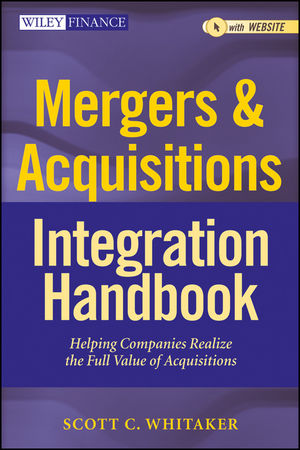
Mergers & Acquisitions Integration Handbook is a comprehensive resource to help companies create a scalable post merger or acquisition integration process and framework that accelerates operating and business benefit goal realization.
Botched integration is the number one reason mergers fail. Mergers & Acquisitions Integration Handbook shows you how to develop, execute and implement merger integrations and business strategies to realize your organization’s mergers and acquisitions goals.
CHAPTER 1 Introduction 1 Who Should Use This Book? 1
How This Book Is Set Up 2
Chapter Summaries 2
A Word to the Wise 4
CHAPTER 2 Mergers and Acquisitions 101 and Assessing Integration Complexity and Risk 7
Mergers and Acquisitions 101 7
Determining Post-Acquisition Integration Scope 8
Assessing Integration Complexity and Risk 11
CHAPTER 3 Making the Business Case for Integration 19
How to Improve Performance 19
The Most Complex Areas 21
Making the Business Case for Integration Support 23
The Challenges of Integration 24
Integration Success Factors 29
CHAPTER 4 An Introduction to Integration Planning 31
Integration Activities 32
Integration Timing 32
Integration and Business Planning 33
Integration Support 35
CHAPTER 5 The Pre-Planning Phase 39
Key Activities 39
Reviewing the Planning Documents 40
Assessing Potential Challenge Areas 42
CHAPTER 6 The Importance of Due Diligence 47
Due Diligence Documents Lists 48
A Few Words about IT Due Diligence 59
CHAPTER 7 Establishing an Integration Management Office 61
Setting Up an IMO 63
Determining Functional Resource Commitments 66
Dedicated versus Matrixed Resources 68
Setting Up an Integration Project Charter 69
Setting Up an Integration Governance Structure 72
CHAPTER 8 Executing Your Integration Plan 75
Functional Work-Plan Elements 76
Integration Work Streams 77
Functional Work-Plan Quality 79
Functions Requiring Extra Attention 82
CHAPTER 9 Planning Your Integration’s End State 87
How to Know When an Integration Is Finished 88
The Typical Process: Roles, Responsibilities, Tracking, and Finishing Well 88
CHAPTER 10 Effective Communication Planning 95
Communication Planning Objectives 95
Guiding Principles for an Effective Communication Plan 96
Establishing a Communication Matrix 97
A Proper Communication Process 101
CHAPTER 11 Cultural Integration and Assessment 107
Managing Cultural Integration Activities 107
Culture and Change Management 112
CHAPTER 12 The Talent Assessment Process 115
Talent Assessment Guiding Principles 115
Talent Assessment Objectives 116
Evaluation Tools for Assessing Talent 117
Retention and Separation Guidelines and Policies 118
Dependencies for Talent Assessment and Retention and Separation Activities 123
Things to Avoid 125
CHAPTER 13 Synergy Program Management 127
Effectively Managing Synergies 128
The IMO’s Role in Managing a Synergy Program 129
A Typical Synergy Plan 130
Best Practices 137
CHAPTER 14 Information Technology Integration 139
IT’s Role within an Integration 140
Day One Planning 144
The Three Risks 146
CHAPTER 15 Integration Feedback: Lessons Learned 149
Goals and Tools of Lessons Learned 149
Getting Feedback and Making Adjustments 150
Collecting Post-Integration Feedback 151
Additional Tips 153
CHAPTER 16 Creating an Integration Playbook 157
Playbook Contents 157
Playbook Elements 159
How the Elements Work Together 161
Applying the Playbook 162